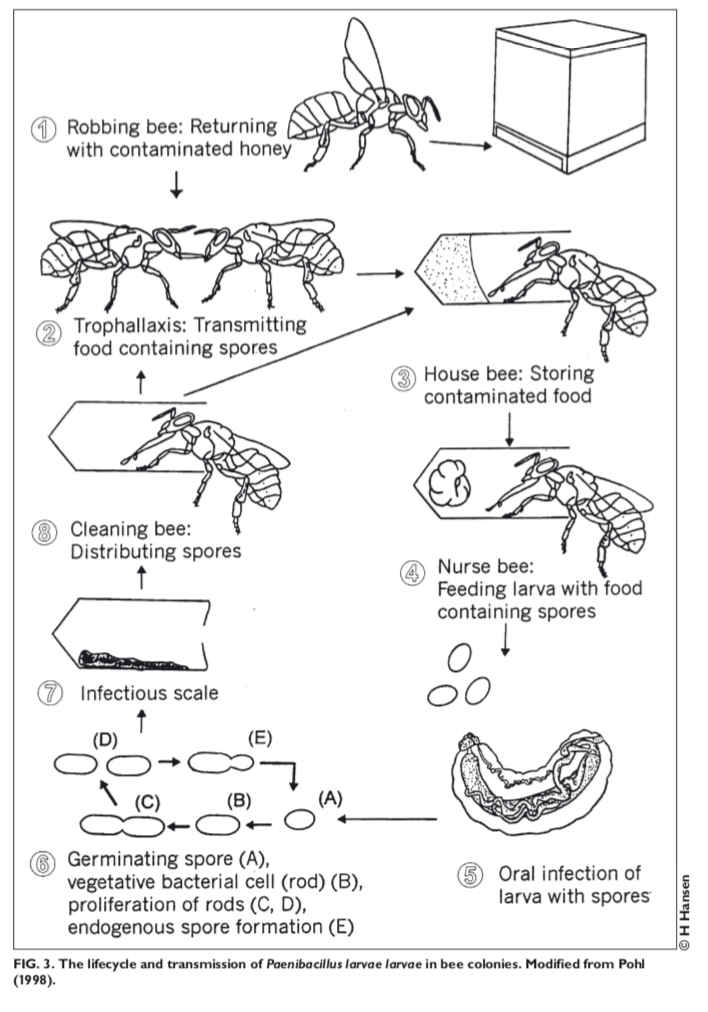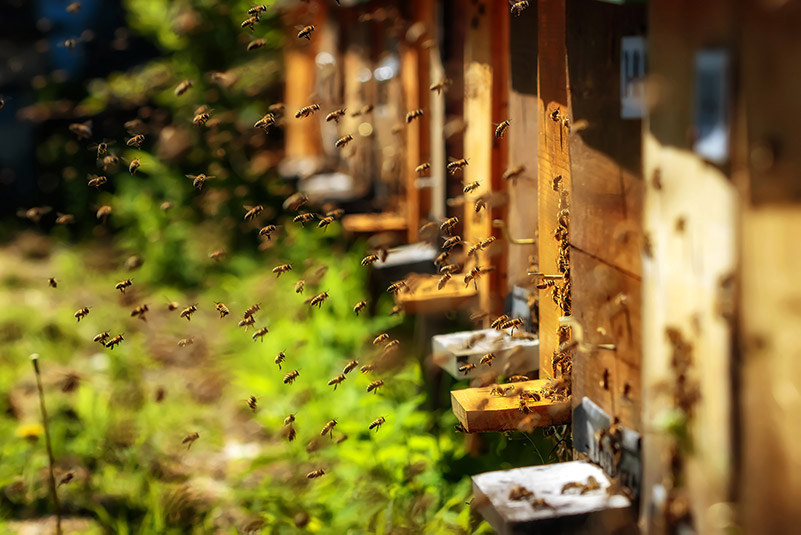What is American Foulbrood?
Industry
Page 03 /
What is American Foulbrood and How is it Transmitted?
American Foulbrood
American foulbrood (AFB) is one of the most important bacterial diseases of honey bees, causing the complete devastation of bee colonies and severe economic consequences. It is also responsible for the majority of antimicrobial use in this commodity group.
The bacteria causing AFB has developed resistance to common antimicrobials used to prevent its occurrence in some areas of Canada. While no resistance has been detected in Ontario, it is important to ensure we use antimicrobials responsibly to ensure we can retain their effectiveness for future use.
AFB is caused by the spore-forming bacteria called Paenibacillus larvae that is specific to honey bees.
It is a highly virulent bacterium that can affect any hive (healthy or weakened), spread by:
- Exchanging hive and bee materials between colonies and beeyards
- Lack of biosecurity practices by beekeepers
- Trading and exchange of bees and beekeeping equipment between beekeepers (i.e. colonies, brood frames), especially those done without the required permit
- Foraging activities of the bees themselves as they will intermingle between different colonies and yards of neighbouring beekeepers
These spores are hardy! The spores produced by the bacteria can survive in the environment for long periods (well over 50 years). They are resistant to freezing and high environmental temperatures. AFB is a disease that cannot be treated, as spores are very difficult to kill.
The best way to ensure your hives are not infected is by using excellent management practices to mitigate its introduction into your hives. AFB can occur depending on the disease status of nearby beekeyards
How Does American Foulbrood Cause Disease?
American foulbrood (AFB) causes disease in hives by infecting the larval stage (particularly larvae less than 24 hours old) of honey bees. Spores produced by the bacteria Paenibacillus larvae are consumed by larvae when they are fed by nurse bees, initiating a fatal infection. New spores are produced in the body of the dying larvae in great numbers (2.5 billion per larva). Dead larvae develop into a hard scale at the bottom of the cell, and then become a source of spores that continue to infect the hive, as adult bees spread spores throughout in their attempts to remove them, and while feeding other larvae.
There are several routes by which AFB can spread among hives or colonies of bees through honey bee activity1:
- Robbing bees: The presence of AFB in the hive weakens it, making it more susceptible to robbing bees. Robbing occurs when invading bees from other colonies steal the honey crop of another colony (either from the same beeyard or nearby beeyard). The robbing bee can inadvertently bring honey from a hive contaminated with AFB spores back to their uninfected hive. Robbing is the most serious mechanism for transmission of AFB through bee activity.
- Drifting bees: This occurs when honey bees from adjacent colonies mistakenly enter another colony. This can cause the introduction of spores into an uninfected hive, or that bee returns to its own hive and introduces spores there
Bees travel several kilometres from their own hive in their normal foraging activities (typically 5 km and up to 10 km if required). If you are in the vicinity of an infected beeyard, your hive may be at risk.
It is less likely that swarms (that have yet to establish a colony with brood comb) are responsible for the spread of AFB on their own, as most do not carry enough spores to initiate infection.
Within the colony, the stages of the life cycle and transmission of AFB-causing bacteria are outlined below1:
- Robbing bee returns to the hive with honey contaminated with AFB spores
- Trophallaxis: Transmitting food containing spores
- House bee: Stores contaminated food
- Nurse bee: Feeds larva with food contaminated with spores
- Oral infection of larva with spores
- Germination of spores within the body of the dying larva
- Fatal infection of larva after brood cell is capped, and creation of infectious AFB scale (the decomposed remnants of the larva)
- Cleaning bees distribute spores via trophallaxis by contaminated mouthparts leading to the continuation of the cycle
The Human Element. It is more common that AFB is spread by human intervention through the transfer of spores.
Some of the routes that beekeepers can spread AFB include:
- Feeding colonies with contaminated pollen (outside sources or unirradiated)
- Feeding colonies with honey contaminated with spores
- Using contaminated brood combs (old infected frames with dry scale or fresh infected brood comb with live bees)
- Using contaminated beehives
- Lack of biosecurity (improper sterilization of beekeeping equipment, wearing reusable gloves and/or clothing, and equipment)
We sat down with Dr. Greg Hawkins, a veterinarian based in southern Ontario who is also the owner and operator of a commercial hive. Greg shares his concerns about perceptions surrounding American Foulbrood, and its potential impacts on Ontario’s industry
References
- Hansen, H., and C.J. Brødsgaard. 1999. American foulbrood: a review of its biology, diagnosis, and control. Bee World. 80:5-23.

